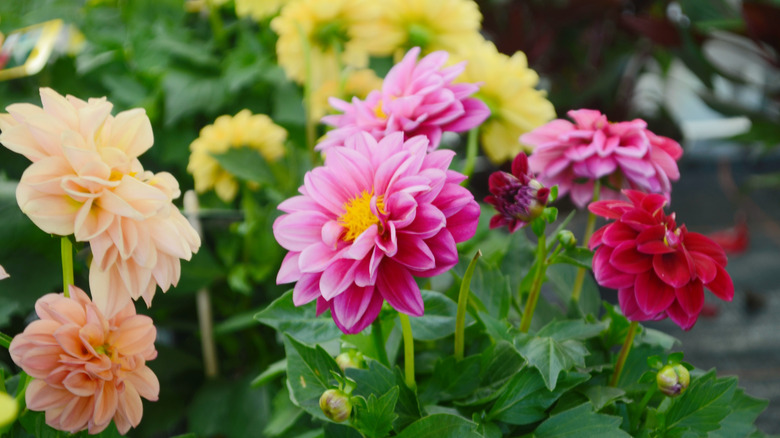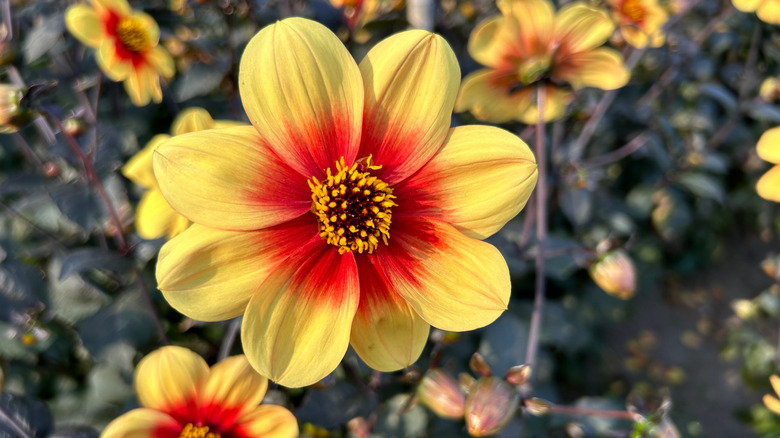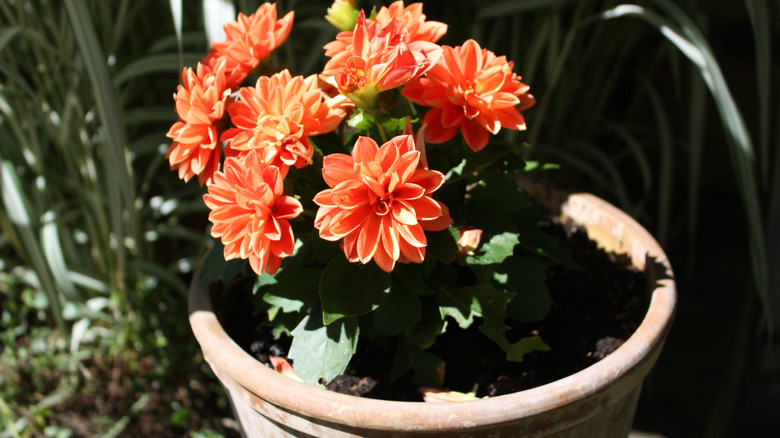Places To Avoid Planting Dahlias For Better Blooms And Growth
If you've never experienced the joy of growing dahlias in your yard, you're in for a treat if you decide to give these outstanding bloomers a try. They're relatively fuss-free to grow and will astound you with their succession of colorful flowers that will continue right through the warmer months of the year. But, in order to get better blooms and exceptional growth, there are places in your garden you should avoid planting dahlias. Whether you're planning to grow dahlias with single or double blooms, avoid planting them in full shade, soggy ground, or soil that's highly alkaline. Your climate is also a consideration because dahlias don't appreciate high humidity or very hot temperatures. And, if you have a container garden and want to add some dahlias, avoid planting them in pots that are too small for the roots to develop fully.
Essentially, the best place to plant dahlias for stunning blooms is in a sunny spot in your yard that receives at least six to eight hours of sunlight daily. This will ensure that they'll reward you with tons of flowers all summer long. If they're grown in a shadier spot, you'll get tall, lanky growth and fewer flowers as the plants strive to get more light. It's even worse if you grow them in full shade because they simply won't flower at all.
Dahlias need well-drained soil
You want to avoid planting dahlias in any areas that might be prone to waterlogging because these plants really do need excellent drainage. The reason for this is that they grow from underground tubers, and these are prone to rotting if they're allowed to sit in water. If all you have in your garden is heavy, clay soil, it's best to grow your dahlias in raised beds or mounds in order to facilitate better drainage. Similarly, dahlias prefer neutral to slightly acidic soil, so if yours is highly alkaline, you'll need to make some amendments by adding sulfur or aged compost, before planting them.
Even though dahlias hail from tropical regions such as Mexico and South America, they don't do well in high heat or humidity. You'll find that they actually grow best in USDA hardiness zones 7 through 10, and the tubers need to be lifted over winter in areas where the ground freezes. When dahlias are subject to temperatures above 90 degrees Fahrenheit, they'll simply stop growing and cease to flower. This is because, in their native habitat, the days might be hot but the nights are cool. The plants have adapted to this type of environment, so, without the cooler nighttime temperatures, they shut down and wait for more ideal conditions to resume growth. For temporary heat waves, you can protect your plants by providing plenty of water, some afternoon shade, and a layer of mulch to keep the soil cooler.
Select dwarf varieties to grow in pots
If you want to grow dahlias in your container garden, you're better off selecting dwarf varieties as these don't need quite as much space to grow. Taller types will suffer when grown in containers, unless your pots are huge to accommodate lots of root growth. If the roots are too cramped, your plants will respond with stunted growth and much fewer flowers. This is important to note because, after all, dahlias are one of the best flowers perfect for a cut flower garden, so you want to give them optimum space to thrive.
Even with dwarf varieties, you'll still want to select a container that's at least 12 inches in diameter and equally as deep. Remember to use a quality potting mix and ensure your planter has plenty of drainage holes. You'll need to water your pots often, as they'll dry out quickly when placed in a sunny location. Also, don't forget to feed your plants regularly if you want an abundance of vibrant blooms. Finally, deadheading spent flowers often (or cutting them to put in vases) will ensure your plant provides you with a continuous supply of flowers. For more tips, you might want to check out the best way to grow dahlias in containers — and common mistakes to avoid.


